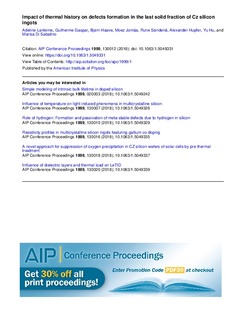| dc.contributor.author | Lanterne, Adeline Anne | |
| dc.contributor.author | Gaspar, Guilherme Manuel Morais | |
| dc.contributor.author | Haave, Bjørn | |
| dc.contributor.author | Jomâa, Moez | |
| dc.contributor.author | Søndenå, Rune | |
| dc.contributor.author | Hupfer, Alexander | |
| dc.contributor.author | Hu, Yu | |
| dc.contributor.author | Sabatino, Marisa Di | |
| dc.date.accessioned | 2018-09-07T06:05:32Z | |
| dc.date.available | 2018-09-07T06:05:32Z | |
| dc.date.created | 2018-09-06T13:16:35Z | |
| dc.date.issued | 2018 | |
| dc.identifier.issn | 0094-243X | |
| dc.identifier.uri | http://hdl.handle.net/11250/2561345 | |
| dc.description.abstract | For the first time, the impact of the tail detachment on the quality of the last solid fraction of a Czochralski silicon ingot body is reported. Simulations of the thermal history were performed on CGSim software and showed that producing an ingot with a tail detached from the melt before the cone-end (the so called “popped-out” tail) changes the time that the last part of the ingot body remains at the 900-1200°C temperature range and could thus impact the growth of defects such as oxygen precipitates. In addition, ingots with tails completely grown were characterized and compared to ingots with popped-out tails. Lifetime measurements of the ingot last solid fraction were performed while voids and oxygen related defects were delineated with chemical etchants. These measurements were complemented with FTIR measurements performed at room and low temperature (30 K), before a two-step thermal oxidation took place. The results show no impact of the earlier detachment from the melt on the as-grown lifetime, as long as the generation and propagation of dislocations due to the detachment are constrained inside the tail. However, after the thermal oxidation, lower oxygen stacking fault density is found in the popped-out ingots, highlighting a possible improvement of the Czochralski quality with shorter tails. | nb_NO |
| dc.language.iso | eng | nb_NO |
| dc.publisher | AIP Publishing | nb_NO |
| dc.title | Impact of thermal history on defects formation in the last solid fraction of Cz silicon ingots | nb_NO |
| dc.type | Journal article | nb_NO |
| dc.type | Peer reviewed | nb_NO |
| dc.description.version | publishedVersion | nb_NO |
| dc.source.volume | 1999 | nb_NO |
| dc.source.journal | AIP Conference Proceedings | nb_NO |
| dc.source.issue | 1 | nb_NO |
| dc.identifier.doi | 10.1063/1.5049331 | |
| dc.identifier.cristin | 1607301 | |
| dc.relation.project | Norges forskningsråd: 193829 | nb_NO |
| dc.description.localcode | Locked until 10.8.2019 due to copyright restrictions. Published by AIP Publishing. This article may be downloaded for personal use only. Any other use requires prior permission of the author and AIP Publishing. The following article appeared in Journal of Applied Physics and may be found at https://aip.scitation.org/doi/abs/10.1063/1.5049331 | nb_NO |
| cristin.unitcode | 194,66,35,0 | |
| cristin.unitname | Institutt for materialteknologi | |
| cristin.ispublished | true | |
| cristin.fulltext | original | |
| cristin.qualitycode | 1 | |
